Capturing great images of birds can be tough in open woodlands or fields. It's even harder in a rainforest. But, as pro shooter Greg Basco explains, when you get it right the rewards are considerable.
Tropical forests are the pinnacle of evolution in environments for birds. They are ecological niches, ecosystems in constant state of flux, and they offer a large geographical variance within a relatively small area. This encourages the development of a huge number of tropical bird species. In Costa Rica, where I live and work, there more bird species than in the entire continental United States, but in an area the size of Denmark. With over 870 species to photograph, you might think I’m in heaven!
Nonetheless, as those of you who have ventured to the tropical rainforest regions of Australia know well, capturing this glorious avian biodiversity with a camera can be very difficult. Many species are secretive and travel through the busy forest canopy and understory. And while there are myriad species, there are very few individuals; just finding a bird to photograph can be difficult. To top it off, the light often is either too harsh or too low to rely on traditional bird photography techniques. Here are some tips to help you make the most out of your next bird photography expedition to the rainforest.
01 GET FLUENT IN STOPS
No creative photography is easy, but bird photography in a tropical forest is more technically challenging than in the open habitats that photographers commonly encounter in temperate zones or the African Savanna. In the tropical forest you’ll have dappled light, harsh light, changing light, and low light on a daily basis. And the lighting can change dramatically as a bird moves to a different branch, sometimes just a short distance away. Understanding the variations with your gear will allow you to tackle these challenges and concentrate on getting the picture rather than fumbling with dials and buttons.
You’ll need to be adept at handling the basic relationship between aperture, shutter speed, and ISO to get the exposure you want. Unlike more open areas, in tropical forests you won’t have the luxury of good depth of field and plenty of shutter speed at a low ISO. Every favourable choice made for one variable means a sacrifice in another. You want more depth of field? How far do you want to take your ISO in order to maintain a reasonable shutter speed? You want more speed? Be prepared to open up your aperture and deal with some noise in post processing. Now add flash into the equation and you get the picture. There’s very little “set and forget” camera work in the tropics!
Thinking in stops of light and making quick calculations on the fly is an essential skill for the tropical bird photographer. Don’t be afraid to experiment, and learn by trial and error how much impact the variation of each step in aperture can make to the look of your image.
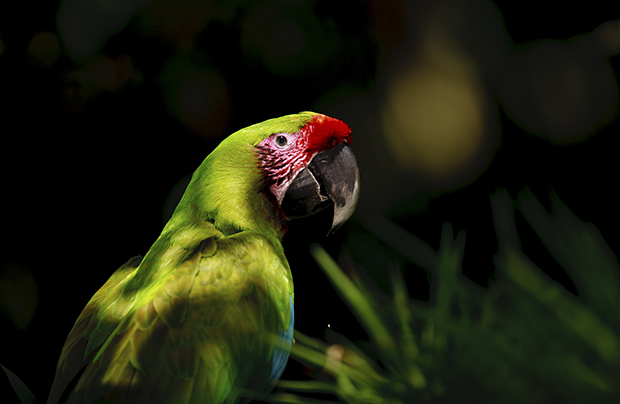 Dappled light with a touch of fill-flash made for a nice portrait of an endangered Great Green Macaw in northern Costa Rica. Canon EOS 5D, 300mm f/2.8 lens, 1/1600s @ f/2.8, ISO 100, handheld, fill-flash at -2. Standard tweaks in Lightroom.
Dappled light with a touch of fill-flash made for a nice portrait of an endangered Great Green Macaw in northern Costa Rica. Canon EOS 5D, 300mm f/2.8 lens, 1/1600s @ f/2.8, ISO 100, handheld, fill-flash at -2. Standard tweaks in Lightroom.
02 CLOUDS ARE GOOD
The normal rhythm of shooting early and late doesn’t apply in tropical forests. While some birds can be more active early and late in the day, cloudy or drizzly weather usually ensures activity throughout the day and it also provides good light for shooting. Because of the sun’s nearly perpendicular position year-round in the tropics, there’s virtually no ‘sweet’ light, and most birds are deep in the forest anyway.
Sunlight means dappled light in the rainforest, and even though dappled light handled properly can produce dramatic images, it’s usually not what you want. So don’t be deterred by cloudy or drizzly conditions, simply be prepared to get out into it. Take adequate rain protection (for you and your camera), use a tripod, and most importantly persevere in challenging conditions. Specific covers are good for you and your kit, but rain protection can even include a small and portable umbrella in certain conditions. Consider all your options.

Cloudy light allowed me to capture all of the tones in this female Great Curassow and to avoid distracting highlights in the background of this picture taken near Costa Rica’s border with Nicaragua. Canon EOS 1D Mk IV, 300mm f/2.8 lens, 1/400s @ f/2.8, ISO 320, handheld. Standard tweaks and slight crop in Lightroom.
03 USE HIGH ISO SETTINGS
Because the best light in tropical forest environments is overcast, you’ll have to deal with low light levels. Modern DSLR cameras vary in their performance, but all can handle high ISO values that were unthinkable just a few years ago. I’ve met many photographers who say they don’t like to shoot higher than ISO 400. Well, good luck with that in the tropics! I would much rather have a slightly noisy, but sharp picture rather than a cleaner file that’s soft. Be prepared to push your camera two to three stops more in ISO than what you’re used to. With a properly exposed file and good processing in the computer, noise can be dealt with quite easily.
An insanely high ISO value was the only way to capture this strange portrait of two active black guan at the very end of a rainy day in a Costa Rican cloud forest. Canon EOS 1D Mark IV, 300 mm f/2.8 lens, 1/500s @ f/2.8, ISO 10,000, handheld. Standard tweaks and selective noise reduction in Lightroom and with Topaz DeNoise.
04 SHALLOW DEPTH OF FIELD
Low light, even coupled with high ISO values, often will require the use of wide apertures. Don’t count on shooting at f/11 or f/8. You’ll need to open the aperture up and get a faster shutter speed in order to capture sharp images. As long as the important part of your subject is sharp, your images will be effective. And don’t think of shallow depth of field as a hindrance. On the contrary, embracing wide apertures can help you to deal with disturbing foregrounds and backgrounds by blurring them out, and they can open up new avenues for more creativity!
A super wide aperture gave a dreamy look to a portrait of a Scarlet Macaw in northern Costa Rica. Canon EOS 1D Mk IV, 300 mm f/2.8 lens, 1/500s @ f/2.8, ISO 1000, handheld. Standard tweaks and selective noise reduction in Lightroom.
05 SLOW SHUTTER SPEEDS CAN HELP
Continuing the low-light theme, there will be times when even pushing your ISO and opening up your aperture won’t be enough. I’ve had workshop clients say they don’t shoot at shutter speeds slower than 1/1000s or 1/500s. I tell them without slow shutter speeds in a rainforest they will need to use at least ISO 25,600! My goal for shutter speed in many instances is 1/200s. On occasion I’ll be able to shoot faster, but not very often, at least without going to absurdly high ISO values. It’s worth remembering that with good technique, wonderfully sharp portraits of even singing forest birds can be made at slow shutter speeds. This is where tripods come into their own.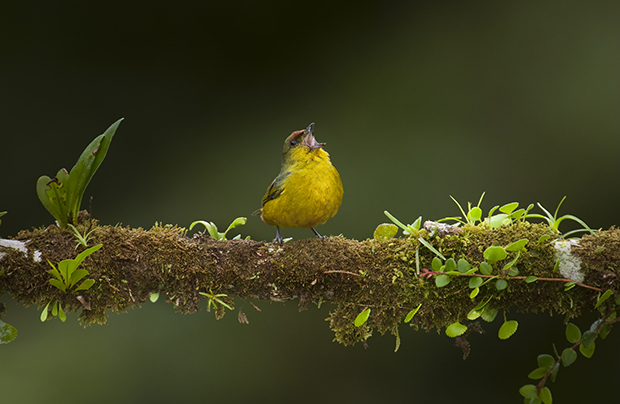
Fill-flash helped me deal with a slow shutter speed and properly illuminated my subject, allowing me to maintain the background luminance I wanted for this early morning portrait of a Resplendent Quetzal in the Talamanca Mountains.
Canon EOS 5D, 300mm f/2.8 lens, 1/160s @ f/2.8, ISO 1000, tripod, fill-flash at -1.3. Standard tweaks and selective noise reduction in Lightroom. Cloning of two small twigs in the lower right corner in Photoshop.
06 USING FILL FLASH
I see a lot of people either embracing flash in the wrong way or shying away from flash for the wrong reasons. Many people simply underexpose the ambient light and crank up the flash when faced with a low-light situation. This is a recipe for a horribly over-flashed picture! Other people have an aversion to flash precisely because they’ve seen these types of pictures. Positioning yourself and setting your exposure such that the ambient light can do most of the work is the key to using fill-flash successfully. Adding in just the amount of flash you need will help to maintain a natural look to your subject while allowing the flash to help you solve harsh light, dynamic range, and low-light issues.
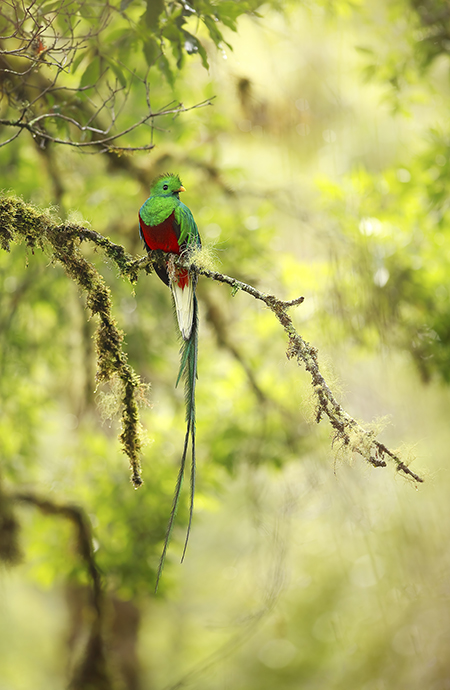
Today I would’ve used a higher ISO to gain some shutter speed for this portrait of a singing Olive-backed Euphonia in a rainforest in the Arenal Volcano National Park. I was limited at the time by my old camera’s ISO range and I had to make do with a slower shutter speed. Canon ESO 20D, 300 mm f/2.8 lens with 1.4x teleconverter, 1/60s @ f/5.6, ISO 400, tripod, fill-flash at -2. Standard tweaks and selective noise reduction in Lightroom.
07 MORE THAN ONE FLASH
Using more than one flash can add accent, drama, and feather detail to a shot balanced with natural light. Using multiple flashes also can allow you to use flash as main light, but in a much more pleasing fashion than if you had the flash mounted in your hotshoe or on a telephoto flash bracket. Multiple-flash hummingbird photography is the classic example of this technique in the New World tropics, but multiple flashes can be used in any situation where the bird’s arrival path is predictable. You’ll want to study the way ambient light produces shadows in order to yield a natural look with your multiple flash work. Flash work that produces no shadow is not pleasing and will look “flashed”. Experimentation is required, as well as an understanding of any regular movements and habits of your subject.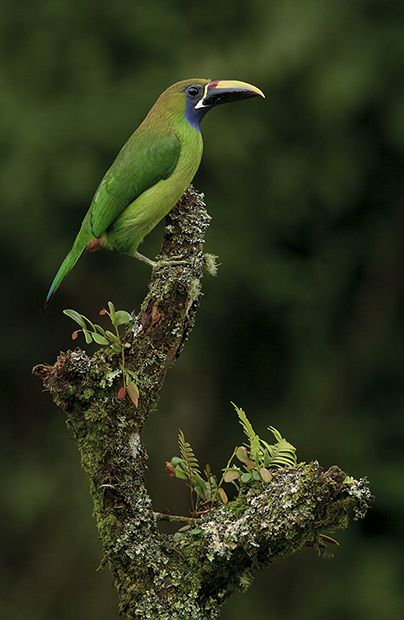
Two off-camera flashes (balanced with a natural, ambient light background) added pop and micro-contrast to the plumage of an Emerald Toucanet in the highlands of Costa Rica. Canon EOS 5D, 300 mm f/2.8 lens, 1/1250s @ f/5.6, ISO 500, tripod, two flashes off-camera. Photographed from a portable blind. Standard tweaks in Lightroom.
08 KNOW YOUR SUBJECT
The lush growth and structural complexity in tropical forests means it’s very hard to get a decent photographic look at a bird. Thus fruiting trees become a gold mine for potential images, and it’s extremely useful to know what types of fruit various birds like to eat. Other species may follow army ants through the forest with the hopes of getting an easy meal. This too can yield fantastic photo opportunities. Learn as much as you can about the species you want to photograph to give yourself the best chance to make quality images. Your dedication to this task will have a direct relationship to your knowledge of your subject, and thus the quality of your subsequent images.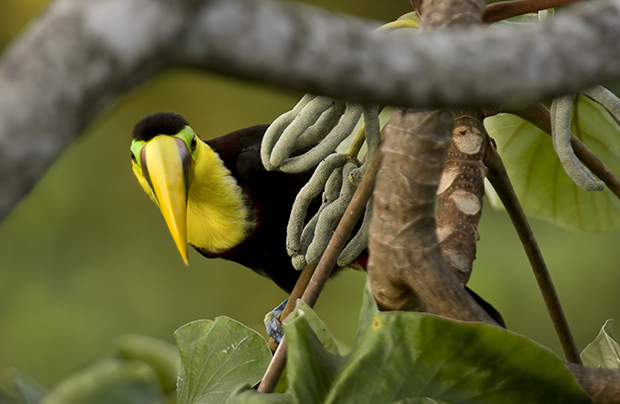
When I saw this Cecropia tree with mature fruit, I went up to a balcony at the lodge where I was staying on a hill above the Pacific Coast to get an eye level view. I knew birds would come at some point to eat the fruits, and it wasn’t long before I was rewarded with this Chestnut-mandibled Toucan. Canon EOS 20D, 300 mm f/2.8 lens with 2x teleconverter, 1/400s @ f/5.6, ISO 200, tripod. Standard tweaks in Lightroom.
09 TRY HANDHELD
While I don’t dispute the fact that working with a long lens on a tripod is the best way to ensure sharp images, there are times when a tripod can also be a hindrance. Imagine you’re stalking a bird through forest undergrowth. Continually setting up your tripod can be difficult because the legs can get tangled up on vines and bamboo. By the time you get set up, your subject can be gone!
In addition, with all of the noise you’re making, the subject probably won’t stick around. Working handheld can allow you to follow a bird with less noise and to be more efficient in squeezing off a shot when things come together. Using a lens with IS/VR/VC/OS is a big help, and combining a wide aperture with a higher ISO will ensure a reasonable shutter speed when you’re handholding a big lens. Finally, bracing yourself and/or your lens on a tree trunk or a branch can help in securing enough sharpness. Just be careful of spines, ants, and arboreal snakes!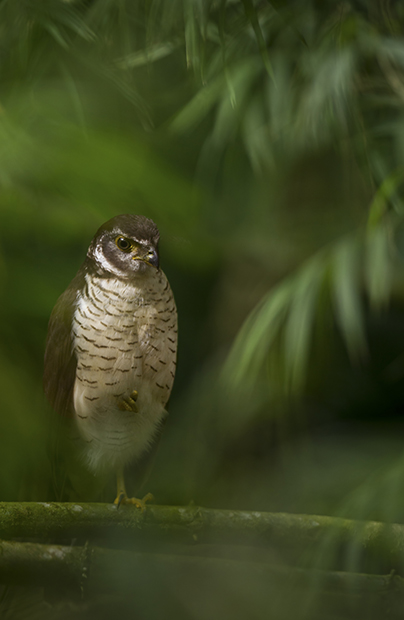
This Barred Forest Falcon was on the move following an army ant swarm in a cloud forest. Working handheld was the only way to keep up with the bird and to avoid having army ants all over my gear! Canon EOS 1D Mk IV, 300 mm f/2.8 lens, 1/640s @ f/2.8, ISO 800, handheld. Standard tweaks in Lightroom. Light healing of a couple of small distracting background elements in Photoshop.
10 DON'T CONDEMN SET-UPS
I see lots of comments on the internet where people disdain set-ups for nature photography. Nonetheless, the opportunity to attract birds to feeders with fruit, seeds, or sugar water can lead to photo opportunities simply not possible by hiking through the forest. I work closely with different lodges and farmers in my tropical workshop destinations to establish and maintain photo-friendly feeder setups. A well-done set-up picture is not as easy as many people seem to believe; a good shot at a set-up also takes an eye for composition and light and knowledge of a target bird’s habits and habitat. I always adhere to rules and policies on public lands related to feeding wildlife, and I use bird calls sparingly. Of course, special caution should be used around nesting birds, as this is a very sensitive stage of our subjects’ life cycle.
A perch set up near a feeder allowed me to capture an elegant portrait of a blue-gray tanager near a cloud forest in Costa Rica’s central volcanic mountain range. Canon ESO 5D, 300mm f/2.8 lens, 1/640s @ f/5.6, ISO 800, tripod, two flashes off-camera. Photographed from a portable blind. Standard tweaks in Lightroom.
11 POST PRODUCTION
I process all of my tropical nature images in Lightroom, using this program for about 95% of what I do. The most important aspect of tropical bird photography in regard to post-production is noise reduction and learning how to do it selectively. Applying noise reduction globally to a picture wipes out all of the feather detail that you worked so hard (and spent so much money!) to capture. While many bird photographers make selections and masks in Photoshop, tropical birds tend to be in fairly busy surroundings compared to a bird against the sky or out in an open field where it’s easy to obtain a smooth background.
Making clean selections becomes more difficult for tropical bird photographs. For this reason I use either Topaz DeNoise (which I find to be quite good at determining what is background and what is bird) or my own little method for doing selective noise reduction right in Lightroom.
Here’s a quick overview of my post-processing workflow for the majority of my tropical bird photographs. Remember that image editing in Lightroom is non-sequential so the order below is of no real consequence. I rarely spend more than a couple of minutes on my tropical bird images. Lightroom is quick and efficient, and I make only minor adjustments to the vast majority of images:
• Determine if any cropping is appropriate; I try as much as possible to frame my subject in-camera so crops are usually slim to none.
• Check for blown highlights and blocked up shadows.Tweak the highlights and shadows sliders accordingly.
• Perform any necessary cloning of dust spots using the clone/heal adjustment tool.
• Scan the image for any specific problem areas (such as ‘hotspots’ on leaves). Address these areas using the selective adjustment brush.
• Scan the image for areas that could use some selective emphasis or de-emphasis (like a bird’s head). Address these areas using the selective adjustment brush (ie; loading up the brush with a touch of positive exposure, clarity, sharpness, and saturation for a bird’s face).
• Determine if noise reduction is necessary and, if so, to what degree. Do selective noise reduction in Lightroom by first applying noise reduction globally and then brushing it out where you don’t want it (ie; the bird) with the selective adjustment brush. If noise reduction in Lightroom seems problematic, I turn to Topaz DeNoise.
• Take a look at the whole image and make any final adjustments (perhaps a touch of clarity and vibrance).
• For final output for print or web, I take the image into Photoshop where I do resizing and sharpening specific to the output device, print, web, etc.
Wrap up
Photographing birds in the tropics brings a whole host of new challenges. Learning what these challenges and limitations are and embracing them instead of fighting against them will lead you to creating more successful images. For more in-depth tutorials and information please consult my e-book, The Guide to Tropical Nature Photography.
I photographed this green-crowned brilliant hummingbird near a Costa Rican cloud forest. Mixing ambient light and flash captured the essence of hummingbird flight. Canon EOS 5D MkII, Canon 70-300 mm lens @ 200 mm, 1/30s @ f/7.1, ISO 640, tripod. One flash, off-camera in manual mode. Standard tweaks in Lightroom.
Greg Basco is a professional photographer based in Costa Rica. He is a BBC/Veolia Wildlife Photographer of the Year and Nature’s Best Windland Smith Rice prize winner. Basco is also co-author of the popular e-book, The Guide to Tropical Nature Photography. He runs Foto Verde Tours, Costa Rica’s first and only travel company specialising in photographic tourism.
You can see more of his work at www.deepgreenphotography.com













